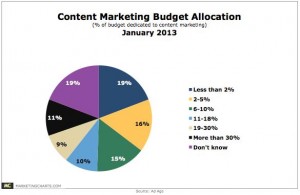
“Excellence, is not an act but, a habit.” – Artistotle
A new AdAge study on content marketing finds marketers are spending 12% of their budgets on content marketing. This is an amazing statistic given how content marketing has exploded on the scene in the last 12-18 months.
Key findings:
- 30% of marketers say they spend their content-creation budget on internal staffing.
- 30% of content creation is handled by third-party partners or suppliers.
- 55% of marketers will increase content-marketing budgets in 2013.
- 8% of marketers told Ad Age they are “very satisfied” the effectiveness.
- 48% say they are “somewhat satisfied.”
Like any good study, these responses uncover challenges, trepidation and unresolved questions.
- How much should be spent on content marketing?
- What is the ROI of content marketing?
- Who owns content marketing?
If these questions seem familiar it’s because they play out, time and time again, with every new concept that is popularized. Every concept seems to through a life cycle of development that mirrors the Five Stages of Grief. I say, popularized, because content marketing, while it may be new to some, it is not really new: it’s been around since at least 1895 when John Deere published The Furrow.
What is new is that the barriers to entry have been lowered; it’s not a matter of printing a glossy magazine and mailing it to customers and prospective customers. The web requires an investment of time, which is certainly like money, and Google’s Panda and Penguin updates, in my view, favor the little guys and gals. Google wants good content, not gaming.
So here’s a shot a few answers to these questions:
How much should be spent on content marketing?
Twelve percent strikes me as a rather small percentage, unless you’ve got a $15 million dollar marketing budget, in which case a smaller percent is still a big piece of pie. The biggest cost of content marketing human resources to produce content: talent. But then that’s true for just about any business function. For those new to the industry, I believe some consulting help is a worthwhile investment to get you started.
You’ll learn a lot from the consulting process, but over time, you’ll begin to realize you have a vast amount of knowledge in your particular industry that a consultant cannot match. Consequently, you’ll be able to do more and more on your own. Even for smaller firms, it’s worth hiring someone dedicated to content marketing.
Still it’s worthwhile to stay engaged with consultants that have expertise in areas such as design for infographics. A good infographic should cost in the ballpark of $3,000. Video can be far more expensive but it really depends on what sort of video you are attempting to create.
What is the ROI of content marketing?
I cannot believe this is even a question. With web analytics it has never been easier – or more definitive – to measure the ROI. When John Deere published a magazine, the company had no idea if people even looked at it unless they wrote a letter in response, or placed an order. Today, we can tell instantly who has clicked on a link, how much time they’ve spent engaged, and whether or not they found the content worth sharing. In other words, we can understand in great detail how content moves around the web.
Who owns content marketing?
Content marketing should be owned by those that produce good content…consistently. Departments and functions can debate strategy and tactics all day long, but what matters the most is doing. In a content marketing world, doing trumps all else. It requires a passion for the role, a love of the pen, a knack for creative ideas, and an inclination for constant improvement. Everyone else, no matter if they come from advertising, branding, direct marketing or PR, is just talking for talking’s sake unless they produce.
Content marketing isn’t an act: it’s a habit.